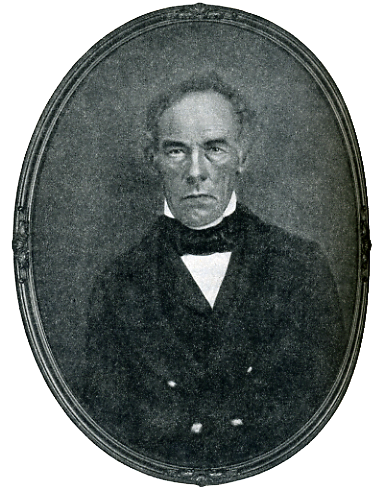Jonas MelvilleJonas Minot Melville came from a well-off family in Nelson, married into a family of merchants in Jaffrey, prospered as an investor and banker, and then lost everything through a combination of bad economic times and unfortunate investment decisions. Yet, Melville was by all accounts a highly moral, honest, self-effacing, and even straightlaced man. He raised money to build the two Congregational Churches in Jaffrey and was a member of both temperance and anti-slavery organizations. The Melvilles built the Stone House on Main Street, probably as close to a “McMansion” as one could find at this time, but Jonas was said to hang his new and fashionable clothes on the line to weather them a bit before wearing them in public Roots in NelsonBorn in 1791, Jonas Melville was the eldest of Josiah and Sarah Minot Melville's four children. Josiah was born in Concord as Josiah Melvin. When he married Sarah Minot in 1790, his father-in-law gave the couple a farm in Packersfield, NH, now Nelson. Josiah Melvin had the family name changed to Melville by an act of NH legislature in 1811. Thus a stoke of the pen turned 20-year-old Jonas and his three siblings into Melvilles. That same year Jonas’s beloved mother died at age 48. Merchant to BankerJonas worked in the family store in Nelson and then went to Boston as a partner with another merchant Isaac Parker, who had married the daughter of Mary (Sarah Melville's sister) and the Reverend Laban Ainsworth. Melville moved to Jaffrey in 1821 where he invested in the First Cotton and Woolen Factory founded by Laban and Mary Ainsworth's son William. In 1823 Jonas married Betsey Lacy, the oldest of eight children born to David and Charlotte Blodgett Lacy. The Lacys were a prominent Jaffrey family – David is listed in the 1790 census as a highway surveyor and his son William Lacy was in the mercantile business. The Melvilles built a brick house in 1824 on land across the Contoocook River near the present day Post Office. In 1829, they built the Stone House which was “said to be the best house on the turnpike from Keene to Boston.” It is now part of St. Patrick’s School and remains a distinctive landmark on Main Street. Jonas and Betsey first attended the Reverend Ainsworth’s Congregational Meetinghouse in Jaffrey Center. By the 1820s, churches other than the Congregational one had formed, notably the Baptists. Laban Ainsworth and his Baptist neighbor Abel Parker had serious arguments over their respective religions. In 1829 the Baptists voted to build their own meetinghouse next to Jonas Melville’s home. Did this action cause Jonas to move across the river to get away from the Baptist adversaries of the Ainsworths or did he simply want a bigger and better house? We will never know. In 1831, the First Church in Jaffrey built the “Brick Church” across the Common from the Meetinghouse. Jonas was treasurer of the Building Committee; he sold stock redeemable in pews returning a cash dividend to investors in a single year. Two decades later Melville raised money for the Jaffrey East Congregational Meetinghouse on land adjacent to the Stone House. Melville Academy
In 1833 Melville persuaded Dr. Luke Howe, Asa Parker, John Fox, and John Felt to help him build the first secondary school in Jaffrey. Melville Academy educated young men and women between the ages of 11 and 20 from the town and beyond, all of whom paid tuition and many of whom boarded in Jaffrey Center. The private academy closed in 1857, reopened as a public elementary school in 1863, and closed forever as a school in 1918 The Jaffrey Center Village Improvement Society acquired the building in 1920 and turned it into a museum. Banking, Railroads, and DisasterJonas Melville loved banking and invested heavily in railroads – and both contributed to his financial downfall. Jaffrey had no banks in the 1840s. So Melville administered estates, served as Town Treasurer and Justice of the Peace, and was a director and president of the bank in New Ipswich and a Winchester bank. Then in 1851, Jonas Melville joined Peter Upton, John Conant, and others in organizing the first Monadnock Bank in Jaffrey. The railroads in the Monadnock region proved to be disappointing financially – building costs were excessive and revenues inadequate. The Panic of 1857 caused railroad and bank stocks to become almost worthless. Depositors panicked and asked bankers to return their deposits, but the banks' investments in railroads and mortgages had lost much of their value. In March 1858, Melville legally assigned all of his property to nephew Josiah Melville and Francis Wright to be sold for the benefit of his creditors. In 1860, Leonard Cutter bought the Stone House for $3,350, noting that “the sale appeared more like a funeral than an auction.” Final Years in PepperellPenniless, the Melvilles moved to Pepperell, Massachusetts in 1859 and lived with the Reverend John E. B. Jewett, who had come to Jaffrey in 1851 as the first pastor of the Jaffrey East Congregational Church. His tenure with the church was brief, but in 1854 Reverend Jewett married Frances Hunt Lacy, the niece of Betsey Melville. The couple lived in the Stone House where two of their children were born. Betsey Melville died on 1863 and Jonas Minot Melville in 1869. Rev. Jewett buried them in his family plot in Pepperell’s Walton Cemetery where a substantial plinth marks the graves. |

Jonas Minot Melville, merchant, investor, banker, and founder of Melville Academy, the first secondary school in Jaffrey.
|

